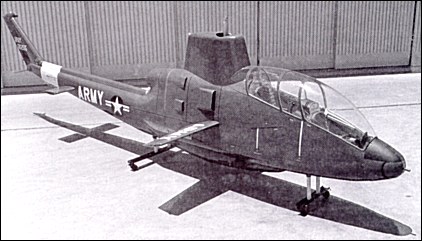
| Bell D-255, D-262 "Iroquios Warrior" |  |
 |

| Bell D-255, D-262 "Iroquios Warrior" |  |
 |
|
In June 1962, Bell invited US Army officials to the Fort Worth facility to see the mock-up of a highly innovative combat helicopter. Known at the time as the Design D-255 "Iroquois Warrior" and wearing false s/n 62-00255 (HU-1F), the new aircraft looked like an hybrid between a fighter and a helicopter. Relatively small, the "Iroquois Warrior" retained several features of the famous "Huey" and had a low silhouette, narrow profile and a small cross-section forward fuselage. This new streamlined fuselage with retractable skids had been designed for maximum speed, armament payload and crew efficiency. It featured a stepped cockpit configuration (nowadays widespread among the world's combat helicopters) with the gunner placed just in front and below the pilot. Armament included a ball-turret in the nose, a streamlined gun compartment under the fuselage and various external loads (including French SS-11 missiles and 2.75in FFAR rocket pods). Although innovative, the D-255 retained the powerplant as well as the basic transmission and rotor system of the well proven UH-1C in order to reduce maintenance and development time as well as to cut costs. On 30 August, 1962, the so-called Howze Board, a study group led by Gen. Hamilton H. Howze, submitted its final report in which recommendations were made for the creation of Air Cavalry Combat Brigades and the design of specific aircraft for that purpose. Bell decided to go further in its company funded attack helicopter research programme but on a reduced cost basis. The first step was to build a flying test-bed by transforming a standard Model 47 into the Model 207 "Sioux Scout", described elsewhere in this book. The flight tests were highly successful but the Army pilots called for a larger turbine-engined aircraft. Bell went back to work on a redesigned scaled-down version of the D-255, known as the D-262, which was entered in the 1964 Advanced Aerial Fire Support System (AAFSS) competition calling for a fast, armoured, heavily-armed helicopter for which Lockheed (with the AH-56A "Cheyenne") and Sikorsky (with the Model S-66) were eventually selected. The D-262 had been eliminated to the great disappointment of the Bell team. A.J.Pelletier "Bell Aircraft since 1935", 1992
|